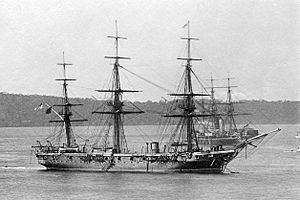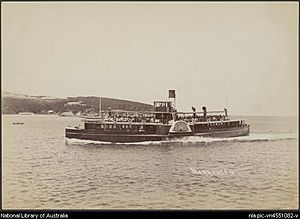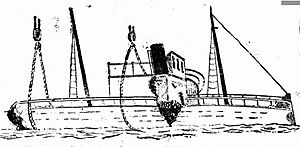SS Kate (tug) facts for kids
SS Kate was a wooden steamship built in 1883 in Balmain, Australia. This ship was quite famous because it was hit and sunk not once, but twice, by ferries from the Port Jackson & Manly Steamship Company!
Quick facts for kids History |
|
|---|---|
| Name | Kate |
| Owner | Richard Manning (1884 - 1887) Government of New South Wales (1887 - 1914) |
| Operator | Mercantile Explosives Department (1887 - 1914) |
| Port of registry |
|
| Builder | Allen & Ward Longnose Point, Balmain, New South Wales, Australia |
| Launched | 6 December 1883 |
| Identification | Sydney registration number: 21/1884 Ship official number: 89238 |
| Fate | Sunk in collision 2 April 1914 |
| General characteristics | |
| Type | Wood carvel screw steamer |
| Tonnage |
|
| Length | 70.3 ft (21.43 m) |
| Beam | 15.8 ft (4.82 m) |
| Draught | 6.5 ft (1.98 m) |
| Installed power | Surface Condensing Compound Engine Cylinder diameters 9 in (22.9 cm) 17 in (43.2 cm), Stroke 14 in (35.6 cm) 20 hp |
| Propulsion | Screw |
Building the SS Kate
The Kate was built from wood at Long Nose Point in Balmain during 1883. The shipyard of Allen & Ward launched her into the water on December 6, 1883. She was officially registered in Sydney to her first owner, Richard Manning, on February 15, 1884.
The Kate was a wooden ship with a single deck and a bridge. She had two masts and was set up with a fore and aft Schooner sail plan. Her back end, called the stern, was shaped like an oval.
Here are some of her main measurements:
- Length from front to back: 70.3 ft (21.43 m)
- Width across the widest part: 15.8 ft (4.82 m)
- Depth of her hold (inside the ship): 6.5 ft (1.98 m)
When she was first built, the Kate weighed about 35.87 gross register tons (GRT) (gross tons) and 24.39 net register tons (NRT) (net tons). She had a special steam engine that helped her move through the water.
The Ship's Adventures
Early Years as a Tugboat (1884-1887)
In her first few years, the Kate mostly worked as a tugboat. Her job was to pull larger ships, like the Avoca and the Freetrader, into Sydney Harbour and help them anchor safely.
In May 1884, just a few months after she was registered, the Kate was considered for a job at the Cape Hawke River. However, another tugboat got the job, so the Kate stayed in Sydney Harbour.
A few years later, in July 1886, the tugboat Prince of Wales sank after hitting another ship. The Kate arrived on the scene and helped search for missing crew members. She then towed the damaged ship, Peterborough, back to Sydney Harbour.
Working for the Government (1887-1914)
On February 4, 1887, Richard Manning sold the Kate to the government of New South Wales. The ship then started working for the NSW Mercantile Explosives Department. This department was in charge of managing explosives, like gunpowder, in the area. They looked after special storage ships, called hulks, and later large storage areas at Bantry Bay.
Captain Bellett's Time (1887-1902)
Captain Henry Denham Bellett, an experienced ferry captain, became the master of the Kate. He was in charge of the ship for 17 years until he retired in October 1901.
In October 1888, Captain Bellett saw an unfortunate incident near Milsons Point while on duty. From 1891 to 1895, the Kate regularly towed powder barges to Barrenjoey.
In January 1891, the Kate was used for a fun outing! Officers from a government department had their yearly picnic on board. They sailed around the harbour and had lunch at Fig Tree Point.
In April 1895, the launch Marvel sank while sailing from Barrenjoey to Sydney. The crew of the Kate saw it happen, but since another boat, the Theresa, was already rescuing the crew, the Kate continued on her way.
The First Sinking: Collision with Narrabeen (1898)
On August 22, 1898, a thick fog covered Sydney Harbour. The ferry Narrabeen left Manly and had to slow down because of the fog. Suddenly, the crew of the Narrabeen saw the Kate coming around Garden Island, towing a powder lighter.
The Narrabeen struck the Kate near the middle, tearing a big hole in her side. The captain and crew of the Kate quickly jumped onto the Narrabeen as their ship began to sink. The Kate disappeared stern-first into the water. The powder lighter, called Me Mel, which the Kate was towing, broke free and almost crashed into the island.
The Kate sank in about 8 fathoms (14.63 m) of water, not far from Garden Island. Later that week, the Kate was successfully raised from the water. She was then towed to Farm Cove to be repaired. At the time, the Kate was valued at about £1500. An investigation found that the collision was caused by the dense fog and a mistake by the Narrabeen's captain.
Back in Service After Repairs

After being repaired, the Kate continued her duties. In April 1899, she helped the New South Wales Naval Brigade with their training exercises. She acted as a "powder boat" for HMS Wolverine, which was a training ship for the naval forces.
In August 1899, the Kate also followed a rowing race held by the Naval Brigade, showing how important these events were.
In August 1901, the Kate's acting master, William John Weldon, found a ship carrying electric detonators (a type of explosive) in Sydney Harbour where it wasn't allowed. The ship's captain was fined for breaking the rules.
Captain Collins' Time (1902-1914)
Captain Jeremiah Collins took over as master of the Kate in November 1902.
In March 1906, the Kate, while towing a powder barge, almost hit a small boat called Toreador in Middle Harbour. The people in the Toreador yelled out, and someone on the Kate rushed to the wheel to change course, but it was almost too late. The Kate hit the Toreador, causing it to break and half-fill with water. The brothers in the small boat fell overboard but were safe.
In May 2011, the Kate was nearby when a fire broke out on the tourist steamer Kookaburra. The crew of the Kate were the first to help put out the flames.
The Final Collision and Sinking
On April 2, 1914, the Kate was towing a lighter (a type of barge) up Sydney Harbour, heading towards Woolloomooloo Bay. As she passed Dobroyd Head, the captain of the Kate saw a half-sunken boat in the distance. Thinking someone might be in trouble, he turned the Kate to go investigate.
As the Kate turned, her captain suddenly saw the large Manly ferry Bellubera heading straight for them, only about 150 yards (137.16 m) away! The Bellubera was going fast, about 12 knots. The Kate had turned right into the path of the much larger ferry.
The Belluberas engines were quickly put into reverse, but it was too late. About 20 seconds later, the Bellubera crashed into the Kate almost in the middle, cutting deep into her side. The captain of the Bellubera saw the Kate sinking and immediately launched a lifeboat to rescue the crew. Lifebuoys were also thrown to the men, two of whom had climbed onto the bottom of the capsized lighter. The Kates crew included Captain J. Collins, engineer Thomas Crawley Jnr., deckhand A. Webb, and steersman H. Arnemann.
The Bellubera was not badly damaged, only having some paint scratched off. Pieces of wreckage from the Kate were found stuck to the Bellubera's side. After a quick check, the Bellubera was able to continue her ferry trips.
An investigation into the collision found that the Kate's captain caused the accident by changing course to look at the sunken boat. However, because the Kate was a government vessel, the court decided it didn't have the power to punish the captain, especially since he was trying to help someone in distress.




